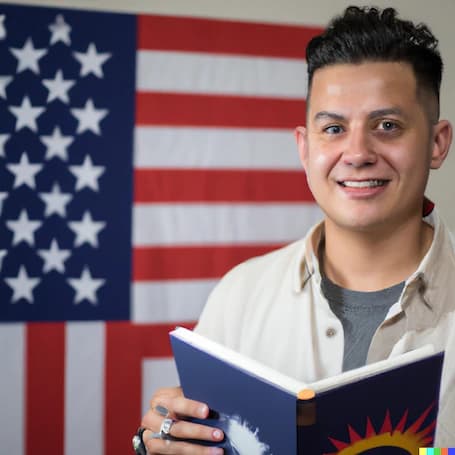A step-by-step guide to US college application for Nepali students

Key Highlights
- Start your application process early to meet deadlines and consider Spring, Summer, or Fall intakes.
- If you excel in standardized tests like SAT/ACT, aim for the Fall intake to maximize scholarship opportunities.
- Use supporting materials like resumes or certificates to apply for additional scholarships from universities.
- After receiving your I-20 form, apply for a US student visa by filling out the DS-160 form and paying necessary fees.
For numerous Nepali students, pursuing higher education in the United States is a lifelong dream. They aspire to receive a top-notch education and gain valuable work experience by interning or working with some of the world's best US companies. If you are a Nepali student, this blog will provide you with a comprehensive guide on how to apply to US colleges from Nepal. We will cover all the necessary steps, documents, and tips to ensure that you submit a successful application and maximize your chances of being accepted into a US college.
Start Early:
You have to start your preparation for the US college application process as early as possible. This will provide sufficient time to complete all necessary steps and meet the application deadlines. Then, you should also keep in mind that US universities typically have three intakes for new students: the Spring Intake in January, the Fall Intake in August, and the Summer Intake in June. Generally, most Nepali students apply for Fall or Spring intake. Before applying to a certain intake you should consider this:
-
If you think you can get good score in Standarized tests such as SAT / ACT / GRE / GMAT then your best option is to apply for Fall Intake where there will be maximum scholarships awarded. Therefore, if you secure good tests score and you have good GPA then, you can get full scholarship and study for FREE in USA.
-
However, if you are not interested in taking standarized tests or think you will get low score on tests, then you can apply for either Spring, Fall or Summer intake because the scholarship amount would be similar. Many universities in the US provide 40% - 60% scholarship based on your GPA, therefore, find these universities and apply.
You should start preparing and applying three to four months before the university intake to ensure a smooth application process.
Research for the Suitable US University
Finding the right US university for your desired program of study is a crucial step in the application process. To do this, start by researching universities that have good rankings in your intended field. For example, if you want to study Biology, you can use Google or consult rankings from reputable sources such as U.S. News and Reports to find universities that excel in Biology research. Additionally, you can visit the USEF Nepal office in Gyaneshwor, Kathmandu, as it is the US-designated official commission for education exchanges between the United States and Nepal (Fulbright Commission). At USEF Nepal, you can network with other Nepali students applying to US universities. "USA Study Visa for Nepali Students (USVNS)," a Facebook group for Nepali students seeking help in searching and applying to universities, can also be a valuable resource. If you require guidance on the application process, you may also visit US education consultancies in Nepal, but make sure to verify the consultancy's reliability. While searching, consider the university's tuition fees and living expenses. If the total cost of attendance (tuition fees + living expenses + books) exceeds your financial capacity, the university may not issue an I-20. Look out for universities that offer scholarships based on your GPA, TOEFL/IELTS, and SAT/GRE/GMAT/ACT scores, as many universities provide merit-based scholarships.
Gathering Documents for Your College Application:
You must prepare documents and give an English proficiency language test before applying to University. Some universities may not require English proficiency language tests, however, you might not get a visa in the university because the counselor might suspect that you are not a genuine student as you have not done TOEFL or IELTS. Other than that you need to have following documents:
-
Letter of Recommendations [3]
Most universities require two or three letters of recommendation with your college application. Therefore, get three letters of recommendation from your teachers and professors. If you have job experience then, you can get one letter of recommendation from your employer too.
-
Attest Educational Transcripts from USEF Nepal
When applying to US universities, you'll need to send your educational transcripts to the schools for evaluation. As Nepali students receive only one set of original transcripts, it's important to have them attested by USEF Nepal in Gyaneshwor, Kathmandu. Attesting your transcripts costs Rs. 50 per page. However, do not send your original transcript; instead, send only the attested transcripts. Some universities may also ask for a World Education Service (WES) evaluation of your transcripts, which requires an additional fee to have them evaluated and sent to the university.
-
Application Essay [Bachelor’s Degree applicant Only]
Application essay is one of the most important aspects of your college application. This essay is what sets you apart from other international applicants who may have similar academic credentials. The application essay is your chance to make a lasting impression on the admission office, as it's one of the few parts of your application that isn't measured by numbers or scores. This means that it's important to invest a considerable amount of time and effort into crafting a compelling and well-written essay. To ensure your essay is effective, consider seeking out resources online and on platforms like YouTube and TikTok for tips and guidance.
-
Personal Statement / Statement of Purpose [Graduate Degree Applicant]
If you're a graduate-level applicant, you'll need to submit a Personal Statement or Statement of Purpose along with your application. This document is similar to the application essay but requires a higher level of knowledge, experience, and wisdom from an entry-level college applicant. In your statement, you should demonstrate your qualifications and commitment to your chosen field. You can share experiences, people, and events that inspired you to pursue this field and discuss how you became interested in it. It's also important to mention your career goals and how they relate to your chosen field. Make sure to research the program and professors thoroughly and explain why the program is an excellent fit for you. Your statement is your opportunity to impress the admission committee with your dedication and passion for your field.
-
English Proficiency Test (TOEFL / IELTS / PTE / Duolingo)
Most US universities require you to submit an English Proficiency Test (TOEFL / IELTS /PTE) scores. TOEFL is accepted by all the US universities. If you have given IELTS or PTE, you need to make sure the university accepts these scores.
-
Standardized tests score ( SAT / ACT / GRE / GMAT )
If you're applying to top US universities and hoping to increase your chances of acceptance or receiving full scholarships, consider taking standardized tests such as the SAT, ACT, GRE, or GMAT. Standardized test scores can demonstrate your educational understanding to the admissions committee. Undergraduate applicants typically take the SAT, ACT, or SAT Subject Tests, while graduate level students usually take the GRE or GMAT. Keep in mind that you'll need to send your score reports directly to the colleges or universities through the testing program.
-
Bank Statements
When you are accepted by a US university or college, you will need to provide bank statements to show that you have sufficient funds to support yourself during your studies.The amount of funds required will depend on the cost of attendance indicated on your I-20 form. The bank statements are used to demonstrate that you have enough money to support yourself during your studies. Nepali students can provide bank statements from any bank in Nepal such as Himalayan Bank, Everest Bank, Nabil Bank and Citizen bank. While US universities generally don't verify the authenticity of the statements, it's important to ensure that the amount shown in the statement matches the cost of attendance indicated in the I-20 form.
-
Supporting Materials
Supporting materials can provide an extra advantage in your college application. It can be either a resume or any form of create work you have done before. For example: if you have published articles in a newspaper, then, you can send a scan of it. Also, if you have received awards in sports such as cricket or football, you can attach your certificates. Such documents will showcase your versatility and enhance your likelihood of being awarded a scholarship and being accepted at the university.
Apply to the University using the University Portal or Common App
Once you have selected the university, you can begin the application process through the university portal or the Common App (only applicable for undergraduate (Bachelor's) studies in the US). Masters and PhD students should apply through the university portal. You need to follow theses steps to apply through university portal:
-
Visit the university's official website and click "Apply Now."
-
Sign up for an account with your email address and password and add personal details such as your phone number, birthdate, and country as requested.
-
Once you've signed up, you can access your account in the portal and start your application by filling out the form. This includes your basic personal information, academic information, and parental information.
-
Some universities have a place for attaching test scores, unofficial transcripts, bank statements, and letters of recommendation. Others may ask for these later in the process.
-
If essays are required for the university admission process, there will be a space for file attachments in the online application.
-
Once you've finished filling out the application, review it and submit it. If the university has an application fee, you'll need to pay it or use a waiver code if you have one.
-
Keep an eye on your email and submit any required documents requested by the university on time.
For Bachelor's students, you have the option of using either the university portal or Common App. To learn more about the differences between the two methods, check out our blog Choosing between University Portal and Common App. After submitting your application, you will need to wait for approximately 1-3 months for a response from the university.
How many universities should you apply?
Determining the number of universities to apply to is a personal decision and there is no specific requirement. However, it is advisable to apply to at least 2 to 5 universities. A recommended approach is to apply to 2 high-ranking universities where acceptance is competitive, and then apply to 2 additional universities where acceptance is more likely and potential scholarships are available. This will give you the opportunity to choose from multiple acceptances and determine which university best aligns with your academic goals and financial capacity.
University Acceptance and I-20 Issuance
Once the university send your acceptance letter to you via your email. You can start further processing such as asking them to issue an I-20. If you are accepted from multiple schools, you need to choose one university which fits your financial capacity and provides more scholarship. Then, you can ask the university to issue you I-20. Then, university will issue a sample I-20 and ask you to provide proof of funding above the cost of attendance (tuition fees + living expenses + books) provided in the I-20 form. After you submit your proof of funding, such as bank statements, the university will send you a hard copy of the I-20 that you can take to the embassy for your visa interview. Once you are accepted, you can apply for additional scholarships at the university by providing supporting materials such as resumes, certificates, or any other creative works. For example, a Nepali student was awarded an athlete scholarship at a Georgia Tech University in the US by sharing his past achievements in football tournaments. You can inquire about these scholarships from the university contact or search their website. Keeping an eye out for these scholarships can make your life in the US more manageable.
Next Steps:
After you receive the I-20 form from the university, the next step is to apply for a US student visa at the embassy. You can apply the US student visa by filling out the DS-160 form, paying SEVIS and visa interview fee. For more detailed guidance on how to apply for a US student visa, you can refer to our comprehensive guide for Nepali students on How to apply for F1 student visa in USA





